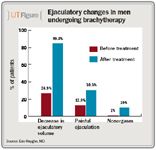Article
Brachytherapy may adversely affect ejaculation
After brachytherapy, 81.3% of men responding to a survey reported successful ejaculation and 90% reported successful orgasm. But the number of men reporting rare ejaculation or no ejaculation at all doubled.

"Active surveillance, brachytherapy, external beam radiation, and radical prostatectomy are all appropriate for localized, low-risk prostate cancer, according to current guidelines. But we do not have clear data on how these therapies affect ejaculation and orgasm," said Eric Huyghe, MD, an oncologist at Universite Paul Sabatier, Toulouse, France. "These elements of male sexual functioning are not very well studied."
Dr. Huyghe presented one of the first detailed analyses of ejaculation and orgasm following permanent 125 I brachytherapy at the AUA annual meeting in San Francisco. Researchers at Universite Paul Sabatier mailed a sexual function survey to a series of 270 sexually active men treated with brachytherapy at a local cancer center. Of the initial group, 241 men (89%) agreed to participate in the mail survey covering five ejaculatory domains: frequency, volume, dry ejaculation, pleasure (orgasm), and pain. The questionnaire was based on the standard Male Sexual Health Questionnaire (MSHQ).
Increase in ejaculatory problems
After brachytherapy, 81.3% of men reported successful ejaculation and 90% reported successful orgasm. But the number of men reporting rare ejaculation or no ejaculation at all doubled (p<.0001). Rare or absent ejaculation after brachytherapy correlated significantly with both older age (p<.001) and pre-implant score on the International Index of Erectile Function (IIEF) questionnaire (p<.001).
While the majority of men in the study continued to ejaculate following brachytherapy, 84.9% reported a decrease in ejaculatory volume compared to 26.9% before brachytherapy (p<.001), Dr. Huyghe said. Among men who completed the survey, 18.7% reported dry ejaculation following implantation.
Pain also emerged as a common complaint. After brachytherapy, 30.3% of men reported painful ejaculation compared to 12.9% before implantation (p<.0001). Reporting painful ejaculation was significantly associated with a greater number of implanted 125 I needles (p=.021) and with painful ejaculation before treatment (p<.0001).
While 90% of men reported orgasm after brachytherapy, the reported 10% rate of nonorgasm is sharply higher than the 1% of men who reported an inability to achieve orgasm before treatment. There was also a significant increase in the number of men who reported delayed, difficult, or weak orgasm after treatment (p=.001).
"These results are important, because weak orgasm or painful ejaculation can contribute to a deterioration of satisfactory relationships following implantation," Dr. Huyghe noted.
"Often, these symptoms develop early and progress over time."















